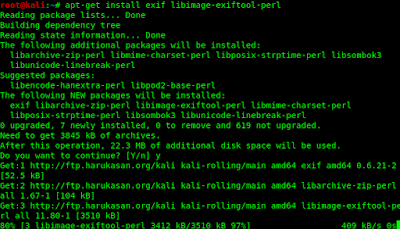

- #Exiftool kali install how to
- #Exiftool kali install install
- #Exiftool kali install update
- #Exiftool kali install password
NOTE: Depending on your installation type, the ResourceSpace config.php file will be located in the following paths:Īpproach A (Bitnami installations using system packages): installdir/resourcespace/include/config.phpĪpproach B (Self-contained Bitnami installations): installdir/apps/resourcespace/htdocs/include/config.php
#Exiftool kali install update
Update the config.php file by adding the line below to it:
#Exiftool kali install install
Log in to the server console and execute the following command: $ sudo apt-get update & sudo apt-get install -y libimage-exiftool-perl To install the ExifTool component, follow these steps: Users of Bitnami native installers should refer only to the Approach B sections. NOTE: The Approach A sections referred to below do not apply to Bitnami native installers. Learn more about the Bitnami stack environment and about OS X VMs.

On OS X VMs, the installation directory is /opt/bitnami and OS X VM users can click the “Open Terminal” button to run commands.
#Exiftool kali install how to
You can see how to use this tool by looking at the following examples:Įxample 1: metagoofil.py -d -t doc,pdf -l 200 -n 50 -o applefiles -f results.htmlĮxample 2: metagoofil.py -h yes -o applefiles -f results.Before running the commands shown on this page, you should load the Bitnami stack environment by executing the installdir/use_APPNAME script (Linux and MacOS) or by clicking the shortcut in the Start Menu under “Start -> Bitnami APPNAME Stack -> Application console” (Windows). To learn how to work with this tool, pay attention to the following command: metagoofil -d -t xlsx -l 50 -n 25 -o /home o: working directory (location to save downloaded files) h: work with documents in the directory (use “yes” for local analysis) l: limit of results to search (default 200) t: filetype to download (pdf, doc, Xls, ppt, ODP, ods, Docx, xlsx, pptx) You can also work with the tool with the following commands: You can use the -h switch as follows to view the tool switches guide: metagoofil -h Note that this tool does not have a graphical version. After downloading the tool, enter the desired folder and run it with the following command: python metagoofil

To hide text file in Image in Kali Linux using steghide, use the following. picture.jpg is the file where I am going to hide secret.txt file. Note: You need Python version 2 to run this tool. I created a folder steghide in root home folder and placed picture.jpg and secret.txt file in there. Therefore, you must install it using the following commands to search for sensitive data of any organization: apt-get update apt-get install metagoofilĪfter installation, just run the following command in the Linux terminal to run the tool: metagoofil If you are using the latest version of Kali Linux, Metagoofil may not be available. In this section, we are going to show you how to install Metagoofil on Kali Linux. The tool also extracts “paths” of documents, where you can get shared resource names, server names, and more.
#Exiftool kali install password
This information can be useful because you can get and use valid usernames, people’s names for use in brute-force password attacks (VPN, FTP, web apps). The files that Metagoofil can extract are with the extensions pdf, doc, Xls, ppt, ODP, ods, Docx, dxlsx, and pptx. To do this, you can define different types of restrictions when searching so that you can get the desired result in the fastest time.

These files can be extracted using the Metagoofil tool. Many websites store documents, images, audio, etc., or put them for users to use, or want to sell a file. Recommended Article: Introducing And Install apktool On Kali Linux Introduction to Metagoofil


 0 kommentar(er)
0 kommentar(er)
